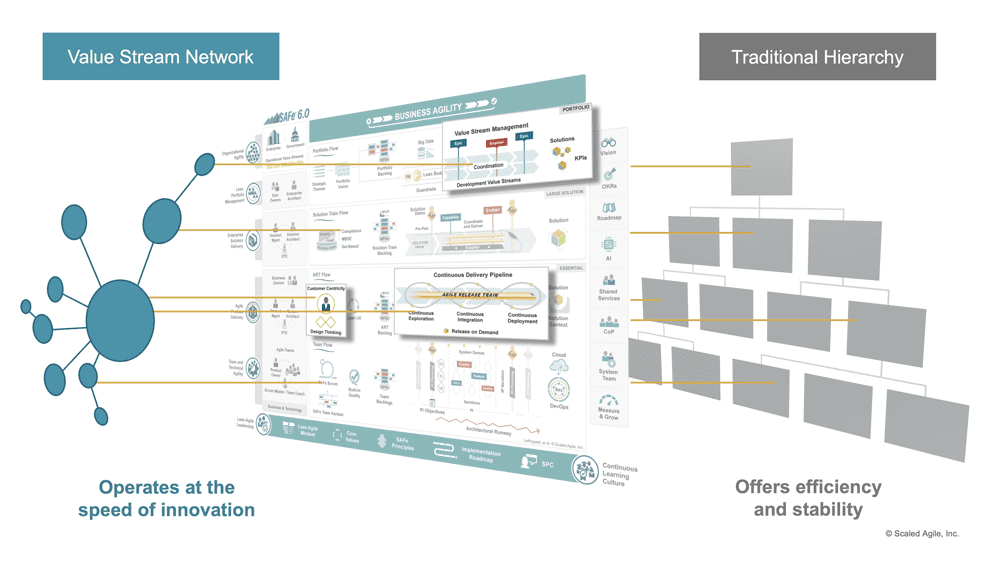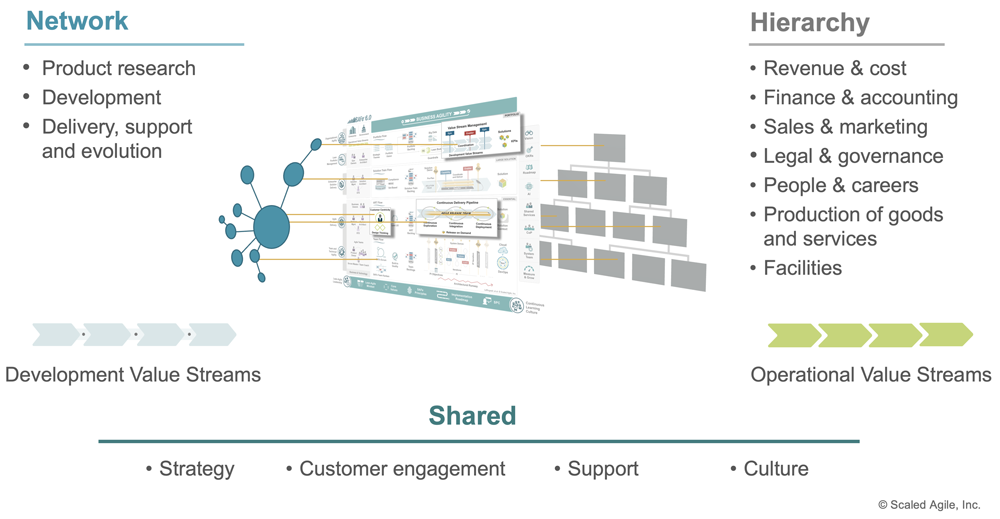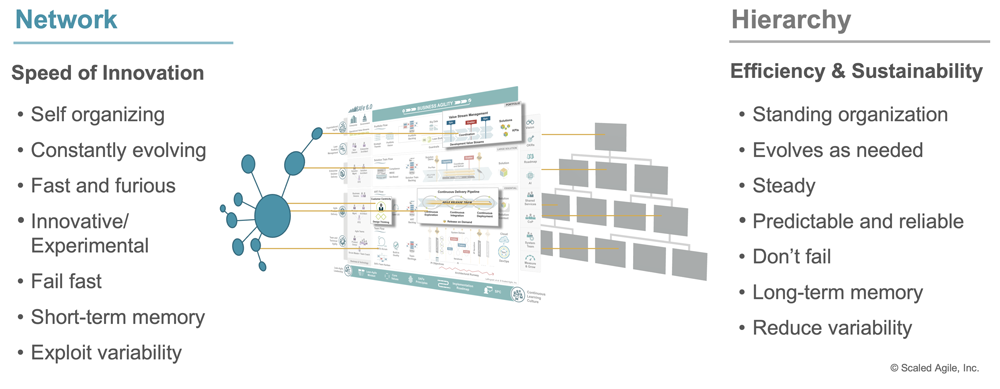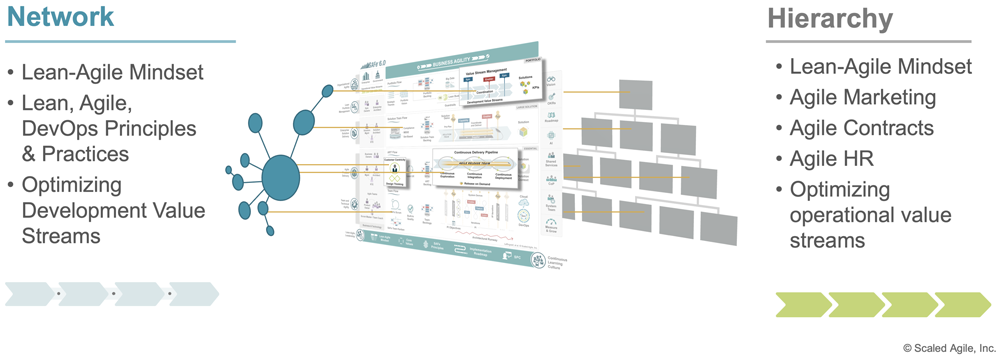The solution is not to trash what we know and start over but instead to reintroduce a second system — one which would be familiar to most successful entrepreneurs.
You need a dual operating system.
—John P. Kotter, XLR8
Balancing the Dual Operating System
With Ian Spence, SAFe Fellow
Note: This article is part of Extended SAFe Guidance and represents official SAFe content that cannot be accessed directly from the Big Picture.
Introduction
SAFe’s focus is to provide the enterprise with the guidance people need to build the innovative, digitally-enabled products and services businesses need to thrive in the digital age. But there is far more to an enterprise than developing such solutions. Enterprises must also take care of customers, partner with suppliers, compensate and develop their people, manage funding and expenses, and operate by industry regulations and the law of the land.
And that doesn’t even include overseeing sales, HR, legal, finance, marketing, health and safety, facilities, administration, manufacturing, production, mergers and acquisitions, and other functions, people, and systems. These ongoing responsibilities require building a long-lived, persistent, and reliable organization that has clear lines of accountability for all these functions pays its bills on time, and fosters an environment for the growth of its people.
The dynamics of sustaining long-term business success while rapidly creating and deploying new digital products present significant challenges. These factors are leading to a changing of the guard and a reduction in the average life expectancy of large companies, particularly those that have not successfully transformed into the new and digital way of working.
As described in SAFe (see Business Agility and Organizing Around Value), one of the most significant changes is understanding that long-term survival requires establishing what Kotter [1] refers to as a Dual Operating System. This operating model balances two needs:
- A dynamic network of people focused on changing the business — developing, evolving, and maintaining new and innovative business solutions
- A stable, functional hierarchy focused on operating and growing a successful, sustainable business that legally and profitably delivers these solutions to the market.
In SAFe, these two parts of the dual operating system are the ‘Development Value Stream Network’ (network for short) and the ‘Functional Hierarchy’ (hierarchy for short), illustrated in Figure 1.

Responsibilities of the Network and the Hierarchy
Each part of the dual operating system must fulfill a distinct set of responsibilities to work effectively. The network’s commitment is to improve business outcomes by providing new and improved solutions. The hierarchy’s responsibility is to sustain and grow current operations and to provide a stable platform for long-term success. These differing goals often lead to tension—and potentially even conflict—within the organization.
Addressing these tensions requires first understanding the differing responsibilities, as Figure 2 illustrates.

Responsibilities of the Hierarchy
As shown in Figure 2, each side of the dual operating system has responsibilities essential to sustaining long-term success. The hierarchy has the most extended list, including activities such as financial and legal governance, people operations, production, and more. One of these responsibilities is consistently selling, producing, delivering, and sustaining the products and services its customers require to do their business. These responsibilities are addressed by a set of Operational Value Streams that manage the flow of value from request to delivery of goods and services and payment.
Responsibilities of the Network
On the surface, at least, the set of responsibilities for the network is much narrower, as it is focused on product research, development, delivery, and evolution. While it is far from a trivial task, the enterprise’s success depends entirely on a single, focused set of responsibilities. To fulfill its mission, the network is the home of the Development Value Streams that define, design, produce, and deploy new innovative digital solutions.
Shared Responsibilities
Figure 2 also illustrates the shared responsibilities that align the Network and the Hierarchy. These include:
- Strategy – A single strategy and vision align the purpose and activities of the network and the hierarchy. And it’s not simply strategy. The dual operating system must also continually align on investment funding (see Balancing Investments below), Agile Portfolio Operations, and Lean Governance. Each of these is described further in the Lean Portfolio Management competency.
- Customer engagement – The hierarchy provides the sales and delivery functions that attract and retain customers; the network engages with customers early in development and ensures that they are delighted by the new products and services.
- Support – The hierarchy typically provides maintenance and support, consulting and advisory services, and community engagement. The network is also directly supporting and maintaining existing products and services.
- Culture – Culture, of course, is shared. Although cultural norms and expected behaviors can vary somewhat based on the nature of the work, successful companies have a unifying culture that encompasses what they do and what they stand for.
However, the network and the hierarchy are not separate organizations; they are two sides of the same coin —the enterprise. Almost everyone in the enterprise will interact with and be involved in the network and the hierarchy. The level of involvement in each will vary by person. But everyone working in the network has a home in the hierarchy. And everyone in the hierarchy sells, supports, and takes pride in the products developed by the network.
How well the network and the hierarchy collaborate and support each other determines the enterprise’s success. The two systems must be balanced and work together, not compete with and undermine one another. In their mutually dependent relationship, neither can succeed without the support of the other.
Optimized for Different Purposes
The network and the hierarchy are structured and optimized to serve the enterprise best, as shown in Figure 3.

The network is optimized for the speed of innovation. As the nature of the work changes, the network can reorganize as necessary so that the right people are working on the right things for the right reason at the right time. No changes to job titles, compensation, or reporting relationships are required. It evolves quickly and constantly as the needs change. It reacts to new opportunities quickly. It’s experimental, innovative, and flexible. It fails fast, learns from that experience, and moves on without guilt or blame. Variability is common. But it isn’t necessarily bad. New libraries, off-the-shelf, cloud-based solutions, and design approaches emerge to enhance speed and adaptability.
The hierarchy is optimized for efficiency and sustainability. There is an intense focus on revenue and profit, achieved by delivering existing ‘horizon one’ (see Figure 5 below) products and services to its customers. It provides a stable structure for compensation and career growth for its people. It manages business operations, collects cash, pays bills, and ensures operations within legal and industry regulations. Mistakes can be costly, so it operates with care and prudence. Material errors are reviewed and analyzed, and policies and procedures are adjusted to prevent making the same mistake. It’s cautious, prudent, and good at what it does. Variability for the hierarchy is rarely positive. Instead, reliability and repeatability are the goals. And for all the right reasons, it views change cautiously—and potentially even as a threat.
Business Agility Requires Continuous Improvement
While at first glance, one might assume that the network is designed primarily for agility and the hierarchy primarily for stability. However, that misrepresents a significant truth–survival in the digital age requires continually improving agility and skills in both the network and hierarchy, as Figure 4 illustrates.

Improving the Network with Lean-Agile Practices
A typical approach with a SAFe implementation is first to establish and begin to optimize the development value stream network. Most of SAFe is dedicated to this purpose. With its Lean-Agile underpinnings, relentless improvement is built into the SAFe. Specific elements include:
- Lean-Agile Mindset and Core Values
- The ten SAFe Principles
- Lean-Agile leadership and the six other core competencies: Continuous Learning Culture, Team and Technical Agility, Agile Product Delivery, Enterprise Solution Delivery, Lean Portfolio Management, and Organizational Agility
- A comprehensive set of role-specific practices and guidance
It’s a well-defined, proven, and disciplined approach to implementation that will provide ever-increasing benefits to the enterprise.
Improving the Hierarchy with Lean-Agile Practices
Even in organizations with a healthy, thriving Network, the hierarchy is often much more significant and may offer even more extensive opportunities for continuous improvement. However, optimizing the hierarchy is more challenging because its operations are more comprehensive and diverse. It is more conservative in its willingness to embrace constant change. In addition, while some enterprises have established a Lean journey, especially those with lean manufacturing experience, Agile methods are not as well-known in the hierarchy. Since they weren’t designed for that purpose, it’s easy to assume they don’t necessarily apply. However, that is not the case, and enterprises are increasingly adopting Lean and Agile methods to enhance operational and overall performance.
SAFe’s recent evolution has partly been driven to help address this more significant challenge. Three core competencies, Lean-Agile Leadership, Continuous Learning Culture, and Organizational Agility, apply equally well and are designed to include that purpose. SAFe has extended guidance in the following areas; each helps large enterprises on their journey to business agility:
Agile Marketing – Marketing groups are increasingly challenged to help their companies meet business objectives while competing for customers’ attention and loyalty. Marketing organizations—specifically product market functions—across industries are rapidly adopting Agile because it helps improve collaboration, gets products to market faster, and better adapts to changing priorities. For more details, see the Agile Marketing with SAFe whitepaper.
Agile Development Contracts – Enterprises often outsource complex systems development to suppliers who can build the buyers of the system needed to integrate with their delivered solutions and run their business. Traditional approaches to contracting range from firm’ firm-fixed price’ to ‘time and materials,’ with almost every point in between. However, most generally understand that neither extreme delivers the best overall economic value. What’s needed is a more Agile approach to contracts, one that benefits both parties in the near and long term (see Agile Contracts).
Agile HR – Competing in the digital age requires competence in developing and delivering technology-enabled systems, unlike before. Such new competencies can no longer be mastered through traditional people structures and practices. A new mindset challenges Human Resources (HR) better address the motivation and compensation practices for knowledge workers. Responsive enterprises act by a) acknowledging talent, knowledge, and leadership as the new currency for competitiveness and b) embracing Lean-Agile values, principles, and practices. For more details, see the whitepaper Agile HR with SAFe: Bringing People Operations into the 21st Century with Lean-Agile Values and Principles.
Optimizing Operational Value streams – Besides the functional areas described above, the hierarchy is vital in delivering the products and services to its customers. This is accomplished by the operational value streams present within the hierarchy. Unlike the development value streams, which are relatively standard, operational value streams are varied from the products and services provided. The nature of operational value streams makes them challenging to reorganize. They don’t just move across the people and functions in the organization. They move across customers and suppliers and occasionally even touch the competition. Optimizing these value streams requires ‘Lean Thinking People and Agile Teams’ and ‘Lean Business Operations’ throughout the enterprise. For more on this topic, see the Organizational Agility core competency.
Balancing Investments
To operate, the enterprise must fund the network and the hierarchy. Figure 5 illustrates how funding is typically allocated.
The hierarchy consumes most of the expenses. They support the functional and administrative areas, revenue generation, and extract profit from existing products. All three investment horizons for the network must be considered to ensure that pursuing short-term gains doesn’t override longer-term investment.
The expense profile on the right of Figure 5 reflects how the hierarchy heavily focuses on Horizon 1 and getting the most significant impact from exploiting the existing product set. But investment, energy, and resources are also required for Horizon 2 products, which will not create a return in the current period. Typically, this strains both sides of the operating systems as innovative but unproven, and products must eventually make their way into recent sales and revenue forecasts. That transition can get a little chaotic as Horizon 1 resources are required, and they were busy before this product appeared. Horizon 3, however, may operate more stand-alone, with a minimal impact on the operations of the hierarchy other than funding.
In addition to Horizon 2 and 3 efforts, the network must continuously invest in innovation and relentlessly improve Horizon 1 solutions. In this way, the network is as practical as it is futuristic and helps balance these forces. This topic is further explored in Lean Budgets.
Summary: Business Agility Requires Agility Across the Entire Enterprise
The dual operating system has proven to be an effective mental model for understanding, organizing, and fulfilling differing responsibilities in the enterprise. It also acknowledges that real business agility requires agility across all enterprise activities.
But, it’s essential to understand that there is only one enterprise. The network and hierarchy are simply two sides of the same company. Each is responsible to the other for enterprise performance. Each has the mandate to increase agility, and responsiveness, reduce waste and hasten time to market. But taken together, they can deliver real business agility and better ensure that the enterprise survives and thrives in the new digital age.
Learn More
[1] Kotter, John P. Accelerate: Building Strategic Agility for a Faster-Moving World. Harvard Business Review Press, 2014.
Last update: 7 March 2023